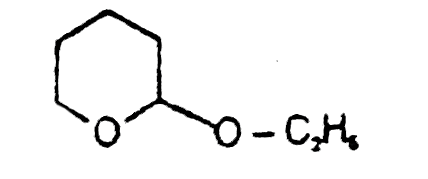In general, the order of hydrolysis among acid derivatives is
RCOCl>RCONH2>RCOOR'>(RCO)2O
RCOCl>(RCO)2O>RCOOR'>RCONH2
(RCO)2O>RCOCl>RCONH2>RCOOR'
RCOOR'>RCOCl>(RCO)2O>RCONH2
The correct Answer is:B
To determine the order of hydrolysis among acid derivatives, we will analyze the reactivity of each type of acid derivative based on their structure and the effects of substituents.
1. Identify the Acid Derivatives:
- Acyl Chloride (RCOCl)
- Anhydride (RCOOR')
- Ester (RCOOR)
- Amide (RCONH2)
2. Analyze the Electrophilicity:
- Acyl Chloride: The presence of chlorine (a good leaving group) increases the electrophilicity of the carbonyl carbon, making it highly reactive towards nucleophiles.
- Anhydride: Anhydrides have two carbonyl groups, and the electron-withdrawing nature of the carbonyl increases the electrophilicity, making them reactive but less so than acyl chlorides.
- Ester: Esters have an alkoxy group (OR) which donates electron density through +I effect, reducing the electrophilicity of the carbonyl carbon, thus they are less reactive than anhydrides.
- Amide: Amides have a nitrogen atom with a lone pair that can participate in resonance with the carbonyl, which significantly decreases the electrophilicity of the carbonyl carbon, making amides the least reactive among these derivatives.
3. Rank the Reactivity:
- Based on the above analysis, we can rank the reactivity of the acid derivatives in terms of their hydrolysis:
- Most Reactive: Acyl Chloride (RCOCl)
- Next: Anhydride (RCOOR')
- Then: Ester (RCOOR)
- Least Reactive: Amide (RCONH2)
4. Final Order of Hydrolysis:
- The order of hydrolysis among the acid derivatives is:
1. Acyl Chloride (most reactive)
2. Anhydride
3. Ester
4. Amide (least reactive)
Final Answer:
The order of hydrolysis among acid derivatives is:
Acyl Chloride > Anhydride > Ester > Amide
---
- Acyl Chloride (RCOCl)
- Anhydride (RCOOR')
- Ester (RCOOR)
- Amide (RCONH2)
- Acyl Chloride: The presence of chlorine (a good leaving group) increases the electrophilicity of the carbonyl carbon, making it highly reactive towards nucleophiles.
- Anhydride: Anhydrides have two carbonyl groups, and the electron-withdrawing nature of the carbonyl increases the electrophilicity, making them reactive but less so than acyl chlorides.
- Ester: Esters have an alkoxy group (OR) which donates electron density through +I effect, reducing the electrophilicity of the carbonyl carbon, thus they are less reactive than anhydrides.
- Amide: Amides have a nitrogen atom with a lone pair that can participate in resonance with the carbonyl, which significantly decreases the electrophilicity of the carbonyl carbon, making amides the least reactive among these derivatives.
- Based on the above analysis, we can rank the reactivity of the acid derivatives in terms of their hydrolysis:
- Most Reactive: Acyl Chloride (RCOCl)
- Next: Anhydride (RCOOR')
- Then: Ester (RCOOR)
- Least Reactive: Amide (RCONH2)
- The order of hydrolysis among the acid derivatives is:
1. Acyl Chloride (most reactive)
2. Anhydride
3. Ester
4. Amide (least reactive)
The order of hydrolysis among acid derivatives is:
Acyl Chloride > Anhydride > Ester > Amide
Similar Questions
Knowledge Check
The decreasing order of acidity of following benzoic acid derivatives is
 AP>Q>R>BQ>P>S>RCS>R>Q>PDR>S>P>Q
AP>Q>R>BQ>P>S>RCS>R>Q>PDR>S>P>QThe decreasing order of acidity of following benzoic acid derivatives is
 AP>Q>R>SBP>R>Q>SCR>P>Q>SDS>R>Q>P
AP>Q>R>SBP>R>Q>SCR>P>Q>SDS>R>Q>PThe decreasing order of acidity of following benzoic acid derivatives is
 AS>Q>R>PBR>Q>P>SCQ>R>S>PDP>Q>S>R
AS>Q>R>PBR>Q>P>SCQ>R>S>PDP>Q>S>R
The decreasing order of acidity of following benzoic acid derivatives is

View SolutionThe decreasing order of acidity of following benzoic acid derivatives is

View SolutionThe decreasing order of acidity of following benzoic acid derivatives is

View SolutionThe decreasing order of acidity of following benzoic acid derivatives is

View SolutionThe decreasing order of acidity of following benzoic acid derivatives is

View Solution

